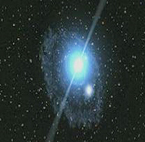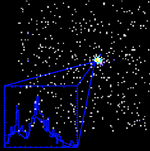
Compton Gamma Ray Observatory
Credit: NASA
Cosmic gamma ray bursts (GRBs) were discovered by accident in the late 1960's by satellites designed to detect gamma rays produced by atomic bomb tests on Earth. The GRBs appear first as a brilliant flash of gamma rays, that rises and falls in a matter of minutes. These bursts are often followed by afterglows at X-ray, optical and radio wavelengths.
A major leap forward in understanding the source of cosmic GRBs was made when the Burst and Transient Source Experiment (BATSE) was launched aboard the Compton Gamma Ray Observatory in 1991.
BATSE had an all-sky monitor that was capable of detecting a GRB virtually anywhere in the sky. Over a period of 9 years BATSE recorded thousands of GRBs, about 1 per day. Among other things, these results showed that the bursts occurred at random all over the sky. If the bursts were associated with objects in our Milky Way Galaxy, they would not show such a universal distribution. Rather, they would be concentrated along the plane of our galaxy like most of the matter in the Milky Way. The BATSE data was so good that it allowed astronomers to also rule out the possibility that the GRBs might be originating in the halo of our galaxy.

Beppo-Sax Satellite
In 1997, astronomers were able to use the Beppo-Sax satellite to refine the location of several GRBs by observing their X-ray afterglow. Then the Hubble Space Telescope and other optical telescopes were used to study the optical afterglow of the GRBs and were able to precisely locate them in galaxies billions of light years from Earth. At such great distances, a GRB must produce enormous amounts of energy. While at their peak, which lasts only a few seconds, they have a power output that is comparable to that of all the galaxies in the universe!
The source of this tremendous energy is unknown. Astronomers have developed a model – the fireball model – that explains the time variation of the bursts, and the shift of the peak radiation to progressively lower energies reasonably well. The model involves matter moving at near the speed of light that collides with other material in the vicinity.
What is the source of this rapidly moving matter? Theories include the merging of neutron stars, or black holes, or the collapse of an extremely massive star to produce what has been called a hypernova.
In one variation of this model, the collapsed core forms a spinning black hole. As surrounding material falls toward this black hole, intense beams of high energy particles and neutrinos eject matter at nearly the speed of light. It is this matter that produces the gamma ray fireball.
X-ray observatories such as Chandra should help to solve the mystery of gamma ray bursts. By studying the X-ray afterglow, they can measure the amount of gas in the vicinity of the burst, and tell which elements are present. This should help to pin down which theory is correct. For example, the Chandra observation of GRB991216 provides evidence for a large, iron-rich cloud moving away from the site of the burst. Although much more work needs to be done, this observation would appear to support the hypernova model.





